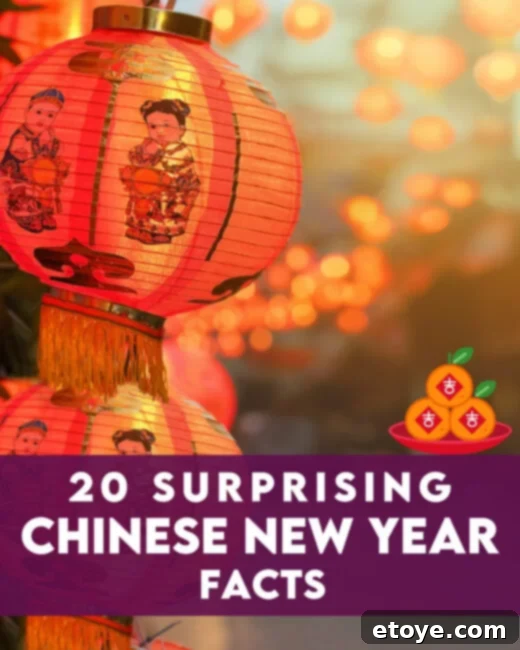While the Western world often associates Chinese New Year with vivid imagery like vibrant red envelopes and majestic Spring Festival dragon dances, these popular depictions only begin to scratch the surface of a holiday rich with countless traditions, deeply rooted customs, and fascinating quirks. Far more than just a single day, Lunar New Year (also known as Spring Festival) unfolds over several weeks, embracing ancient beliefs and modern interpretations.
What began as a pivotal celebration in China has profoundly influenced Chinese communities across the globe, expanding exponentially into various Asian countries such as South Korea, Malaysia, and the Philippines. Each of these nations has gracefully woven its own unique adaptations and local flavors into the fabric of this grand annual festivity, showcasing its incredible cultural adaptability and universal appeal.
However, unless you are deeply embedded within Chinese culture—and sometimes even if you are—many of the more intricate or surprising facts about Lunar New Year might remain unknown. This comprehensive guide aims to illuminate some of the most captivating aspects of this auspicious time, delving into its profound symbolism, age-old practices, and the intriguing taboos that shape the celebrations.
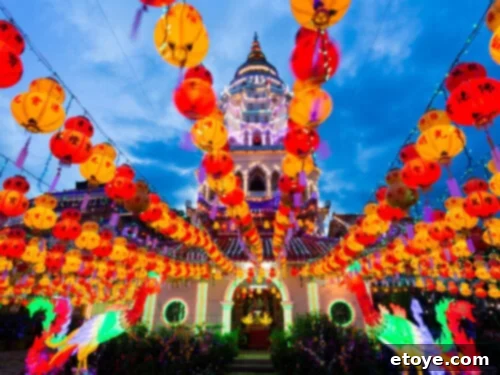
Today, we embark on a journey to explore 20 fascinating traditions, customs, and practices that define the Chinese New Year. Prepare to discover the layers of meaning behind this vibrant holiday and see which of these incredible facts you already knew, and which will surprise you!
1. Round & Golden for Wealth and Abundance

Symbolism forms the bedrock of Chinese New Year celebrations, guiding many choices from decorations to culinary selections. This deep appreciation for symbolic meaning explains why foods that are round and golden are particularly favored during this auspicious period, as they powerfully represent wealth, prosperity, and completeness. A prime example is the traditional Chinese dumpling, or *jiaozi*, which is enthusiastically consumed throughout the 16-day celebration. These crescent-shaped delicacies are said to resemble ancient Chinese silver ingots, making them potent symbols of accumulating wealth for the coming year. Their preparation and consumption are often a communal family activity, further reinforcing bonds and shared aspirations for abundance. Other round foods, such as glutinous rice balls (*tangyuan*), also signify family togetherness and a smooth, complete year.
2. Oranges and Tangerines: Symbols of Joy and Riches
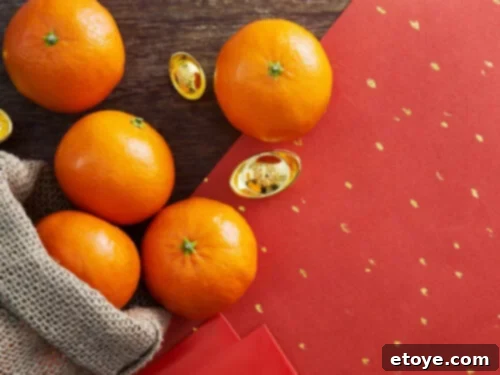
The practice of displaying and exchanging vibrant oranges and tangerines is a cornerstone of Chinese New Year festivities, rooted deeply in linguistic symbolism. These bright citrus fruits are not merely decorative; they carry profound wishes for abundant happiness and prosperity. The Mandarin word for orange, “chéng,” sounds remarkably similar to the word for “success” or “completion,” while “jú” (tangerine) echoes “jǐ” (luck). Exchanging these fruits among loved ones is a heartfelt gesture, a way to reinforce familial and friendly bonds while expressing sincere well wishes: “I wish great things and immense prosperity for you in the new year.” They are often gifted in pairs to emphasize double fortune and presented with both hands as a sign of respect.
3. The Sacred Reunion Dinner: A Family Cornerstone

At the heart of the Chinese New Year celebration lies the Reunion Dinner, held on New Year’s Eve, arguably the most significant meal of the entire year. Its primary purpose is to strengthen family bonds, foster unity, and respectfully honor ancestors. This tradition holds particular poignancy for families whose members are dispersed across different parts of Asia and beyond, as it compels everyone to make the arduous journey home. The table is laden with auspicious dishes, each symbolizing good fortune, longevity, or prosperity, such as fish (for abundance), chicken (for completeness), and noodles (for long life). It’s a cherished time for storytelling, laughter, and reaffirming the unbreakable ties that bind generations together, making it a powerful ritual of belonging and remembrance.
4. Chunyun: The World’s Largest Human Migration
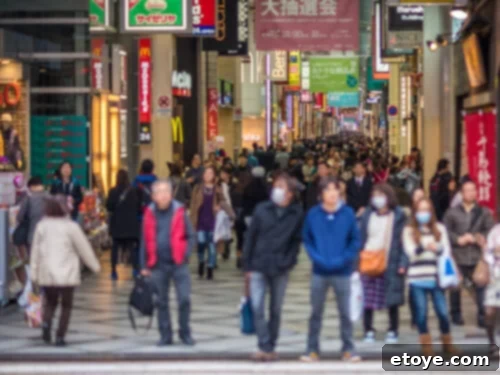
Speaking of “coming home for the holiday,” the period surrounding Chinese New Year triggers what is unequivocally the largest annual human migration on Earth, known as Chunyun, or the Spring Migration. Over a span of roughly 40 days, hundreds of millions, and sometimes billions, of people embark on journeys by train, bus, plane, and car to reunite with their families. This immense movement creates a logistical marvel and an emotional pilgrimage, as migrant workers, students, and professionals travel vast distances to partake in the Reunion Dinner and other festivities. To put its scale into perspective, in 2016 alone, it was predicted that an astonishing 2.9 billion trips would be made during that year’s Chunyun season, highlighting the profound importance of family reunion in Chinese culture.
5. The Power of Words: Forbidden Phrases and Auspicious Speech

During Lunar New Year, the spoken word carries immense weight and is believed to powerfully influence one’s fortune for the entire year. Consequently, language related to misfortune, such as words associated with death, sickness, poverty, financial loss, or arguments, is considered highly taboo and meticulously avoided. These words are thought to attract bad luck and cast a shadow over the auspicious beginning of the new year. In fact, a prevalent belief dictates that the very first words you speak on New Year’s Day are crucial, as they are believed to set the tone and destiny for your whole year ahead. Therefore, people are encouraged to choose their words wisely, focusing on positive affirmations, greetings of prosperity, and wishes for health and happiness to ensure an auspicious start.
6. Appeasing the Kitchen God: A Sweet Tradition
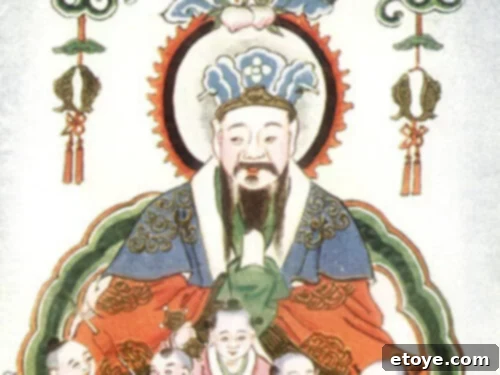
In traditional Chinese households, the Kitchen God (or Stove God), known as Zao Jun or Zao Shen, occupies a position of significant reverence and importance. This domestic deity is believed to oversee every kitchen, observing the family’s conduct throughout the year and protecting the household in various ways. Approximately a week before the main New Year celebrations commence, a paper image of the Kitchen God, typically hung near the back of the stove, is ceremoniously taken down and burned. This ritual symbolizes his ascent to the heavens, where he is tasked with reporting the family’s behavior to the Jade Emperor, the supreme deity in Chinese mythology. Before his departure, families offer sweet foods like sticky rice cakes or malt candy. The dual purpose of these offerings is both to “sweeten up” his report, ensuring he speaks favorably of the family, and, humorously, to make his mouth too sticky to utter any negative remarks, thus guaranteeing only good news reaches the heavens.
7. The Tray of Togetherness: A Sweet Welcome

The “Tray of Togetherness,” often an elegant octagonal or round lacquerware platter, is far more than a simple snack display; it is a profound symbol of hospitality and good fortune during Chinese New Year. Typically filled with six or eight varieties of sweet treats (six for luck, eight for fortune), each item within the tray holds specific auspicious meaning and represents different forms of blessings and health. For instance, candied lotus seeds symbolize fertility, dried kumquats signify prosperity, coconut slices represent companionship, and peanuts denote longevity. This beautifully arranged tray serves as a warm invitation for hosts to welcome guests into their homes, sharing not just delicious snacks but also heartfelt good wishes and hopeful aspirations for a prosperous and harmonious New Year. It embodies the spirit of collective joy and mutual well-being.
8. Whole Fish for Overflowing Prosperity

Serving fish is an absolute must-have dish for the Chinese New Year’s Eve reunion dinner, deeply embedded in a clever linguistic pun. The Mandarin word for *fish*, “yú,” sounds identical to the word for “surplus” or “having extra.” This linguistic connection gives rise to the popular New Year greeting, “Nian Nian You Yu,” meaning “may you have abundance year after year.” The tradition mandates that the fish be served whole, symbolizing completeness, a good beginning, and an auspicious end to the year. Furthermore, it should never be completely finished; a portion of the fish is intentionally left uneaten and stored overnight. This remaining fish symbolizes an overflow of prosperity and good fortune spilling into the new year, embodying the sentiment, “We have so much good fortune, we can’t even finish it all!”
9. Paying Off Debts: A Clean Financial Slate
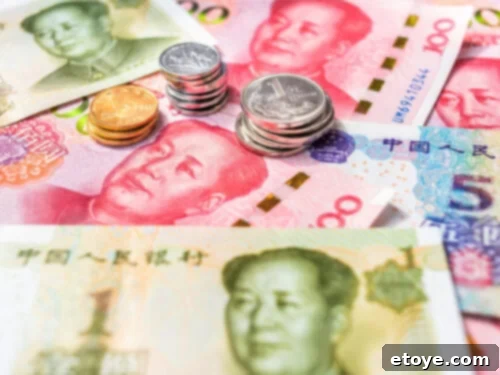
The practice of settling all debts before the arrival of the Chinese New Year is a deeply serious and widely observed tradition within Chinese culture. This custom stems from the powerful belief that carrying debts into the new year invites bad luck and financial misfortune, effectively burdening the future with past liabilities. By meticulously clearing all outstanding financial obligations, individuals and families aim to achieve a “clean slate,” ensuring a fresh and unencumbered start to the new lunar cycle. This financial “spring cleaning” is not just about monetary transactions; it also communicates a sense of responsibility and preparedness to the universe, signaling a readiness for new beginnings and inviting prosperity unhindered by past burdens. It’s a profound act of renewal, both financial and spiritual.
10. Guo Nian: Surviving the Mythical Beast

The ubiquitous phrase “Guo Nian,” one of the common ways to express “Happy New Year!” in Chinese, carries a fascinating historical echo. Literally translating to “surviving the Nian,” its origins are deeply rooted in ancient Chinese folklore and mythology. The Nian was a fearsome, mythical beast said to emerge from its lair at the turn of the new year, preying upon villagers, livestock, and crops. According to legend, the Nian was terrified of loud noises and the color red. In response, villagers developed protective tactics: lighting firecrackers to create deafening sounds and adorning their homes with bright red decorations to scare the monster away. These ancient defense mechanisms evolved into the vibrant firecrackers, festive red lanterns, and elaborate dragon and lion dances that are now synonymous with Chinese New Year celebrations, serving as a powerful reminder of humanity’s triumph over ancient fears and the triumph of light over darkness.
11. Chinese New Year Desserts: Sweet Symbols of Progress
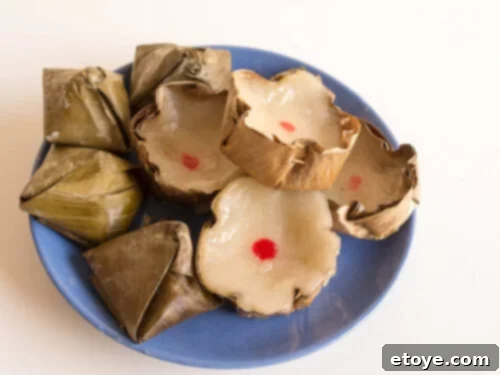
Desserts served during Chinese New Year are far more than mere sweet treats; they are steeped in profound cultural symbolism, each bite carrying wishes for good fortune and prosperity. A prime example is *Nian Gao*, a sticky, chewy glutinous rice cake whose name is a homophone for “higher year.” Eating Nian Gao is therefore believed to bring about growth, progress, and promotion in the coming year. Other popular desserts include *Fa Gao* (prosperity cakes), which resemble blooming flowers and symbolize wealth, and *Tangyuan* (glutinous rice balls), representing family reunion and completeness. These delectable confections add a layer of sweetness and auspicious meaning to the festive table, ensuring that hopes for a brighter future are literally tasted and embraced. For a deeper dive into symbolic Chinese New Year desserts and how to prepare them, click here!
12. Your Zodiac Year: A Time for Caution

Counterintuitively, the year of your Chinese zodiac sign, known as your *Benming Year* (本命年), is not considered a period of heightened luck, but rather one of potential misfortune and challenges. According to traditional beliefs, during your Benming Year, you are said to offend the Tai Sui, the Grand Duke Jupiter, bringing about various obstacles and bad luck. To ward off this negativity and invite good fortune and happiness, wearing red is strongly recommended. Red, a color of auspiciousness and protection in Chinese culture, is believed to repel evil spirits and neutralize the negative influences of the Tai Sui. Some individuals take this tradition to heart, furtively wearing a piece of red clothing—be it socks, insoles, a belt, or even underwear—every day throughout their entire Benming Year to ensure continuous protection and to safeguard their well-being.
13. New Clothes and Haircuts: Shedding the Old, Embracing the New

The period leading up to Chinese New Year is a time of meticulous preparation and symbolic cleansing. Getting new clothes and haircuts before New Year’s Day is a deeply symbolic tradition, representing the shedding of the old, leaving behind any lingering bad luck or misfortunes of the past year, and enthusiastically welcoming a fresh start. It’s about presenting a pristine, renewed self for the auspicious beginning of the lunar cycle. However, a significant taboo dictates against cutting your hair on Chinese New Year’s Day itself, or for several days thereafter. This practice is believed to bring about bad luck and is symbolically associated with “cutting away” one’s good fortune or prosperity for the entire year, emphasizing the careful timing and reverence for specific actions during this sacred period of renewal.
14. The Birthday of All Dogs: A Tribute to Loyalty

In many Asian cultures, dogs are revered as loyal, honest, and intelligent creatures, often considered part of the family. This appreciation is beautifully manifested on the second day of the Chinese New Year, which is traditionally believed to be the collective birthday of all dogs. On this special day, people extend extra care, affection, and often special treats to their furry companions. This tradition serves as a heartfelt acknowledgment of the joy, companionship, and good fortune that dogs are believed to bring into human lives. It’s a way to express gratitude and reinforce the bond between humans and these beloved animals, recognizing their silent contributions to household harmony and happiness, and ensuring they too partake in the festive spirit of renewal and celebration.
15. Avoiding Accidents: Protecting Fortunes for the Year

During the Chinese New Year celebrations, an extraordinary level of caution is exercised to meticulously avoid any accidents or the breaking of objects. This meticulousness stems from a deeply held belief that any mishap or breakage during this auspicious period could foreshadow bad luck, misfortune, or even financial loss for the entire year ahead. To minimize risk, certain activities and objects are completely avoided. For instance, using scissors, knives, or sewing needles is often prohibited, as sharp objects are believed to “cut” away good fortune. Sweeping floors is also avoided on New Year’s Day to prevent “sweeping away” wealth and good luck. The goal is to maintain an atmosphere of peace, harmony, and wholeness, ensuring that the new year begins without any negative omens that could disrupt future prosperity and happiness.
16. Honoring Ancestors: Upholding Family Heritage
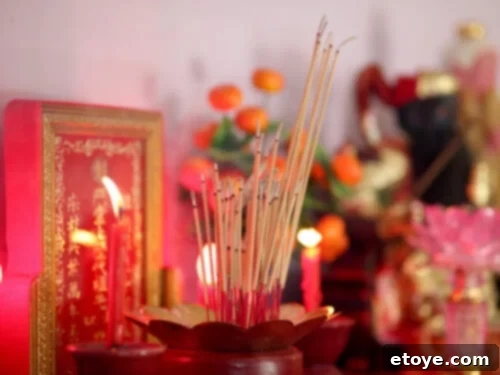
Paying profound respects to ancestors is an incredibly significant and integral part of the Lunar New Year celebrations, serving as a cornerstone of Chinese cultural identity. This deeply rooted tradition reflects the paramount importance of filial piety and the continuity of family lineage. Families typically set up elaborate altars adorned with offerings of food, tea, wine, incense, and paper money. Lighting candles and burning incense are common practices, along with ritualistic bowing or kowtowing before the ancestral tablets or photographs. These acts are not merely symbolic; they are heartfelt expressions of gratitude, remembrance, and the acknowledgment of a rich heritage that connects past generations to the present and future. It’s a powerful way to seek blessings from ancestors for the living, ensuring prosperity, health, and happiness for the family in the coming year.
17. Welcoming the New Year with Open Doors and Windows

As the clock strikes midnight on Chinese New Year’s Eve, marking the transition from the old year to the new, a peculiar but deeply symbolic custom is observed: it is customary to open every door and window in the house. This seemingly simple act is steeped in rich symbolism and spiritual significance. The primary intention is to usher out the old year, along with any lingering bad luck, negative energy, or misfortunes it might carry. Simultaneously, by creating open passages, families believe they are welcoming in the new year, making a clear and unobstructed path for fresh energy, good luck, and abundant prosperity to flow effortlessly into the home. It represents a spiritual cleansing and an optimistic embrace of new beginnings, ensuring the household is ready to receive all the blessings the new lunar cycle has to offer.
18. Hiring Fake Partners: A Modern Social Phenomenon

In recent years, a striking modern phenomenon has emerged in China, highlighting the intense societal and familial pressures faced by young single individuals during the New Year. With the overwhelming expectation from parents and relatives to marry and start a family, many unmarried men and women have resorted to hiring “fake” girlfriends or boyfriends to bring home during the holiday period. This ingenious solution allows them to avoid relentless questioning and parental disappointment. Conversely, some singles who might not have family to visit, or who wish to escape their own family dynamics, rent themselves out as “partners” to earn extra income and experience a different kind of New Year celebration. This practice underscores the evolving social landscape in China, where traditional values frequently clash with contemporary lifestyles and individual choices, creating unique solutions to deeply rooted cultural expectations.
19. The Yule Log: A Glimmer of Warmth and Renewal

While the Yule Log is most commonly associated with Christmas traditions in Western cultures, it also holds significance, albeit in a less universal form, within certain regional Chinese New Year celebrations. Here, it is traditionally decorated with vibrant red ribbons and shimmering glitter, symbols of good fortune and festivity. The burning of this log is a symbolic act, representing the passage of the 12 months of the Chinese year. This ancient practice is believed to bring light, warmth, and purification into the home, effectively banishing any lingering darkness, negativity, or ill-will from the prior year. It’s a ritualistic way to ensure a bright, prosperous, and auspicious start to the new lunar cycle, inviting positive energy and protecting the household from harm.
20. Lantern Festival Riddles: A Festive Test of Wits
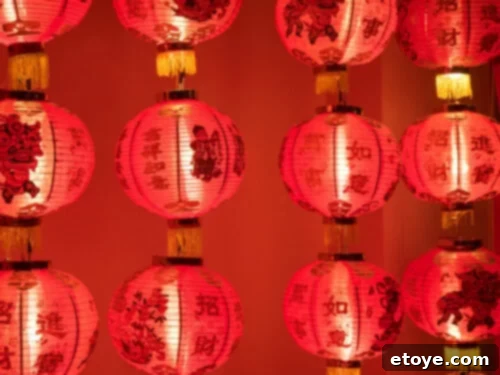
The Lantern Festival, known as Yuan Xiao Jie, officially marks the magnificent culmination of the entire Chinese New Year celebration, typically falling on the 15th day of the first lunar month. This enchanting festival is characterized by elaborate displays of intricate red lanterns, illuminating cities and towns with a magical glow. A beloved tradition during this festival involves riddle-solving competitions, where riddles, often written on the lanterns themselves (*deng mi*), challenge the wit of participants. These “lantern riddles” are not merely a fun pastime; they are a cherished means of fostering intellectual engagement, promoting literacy, and sparking friendly rivalry within the community. Beyond the riddles, the Lantern Festival is also a time for families to gather, admire the beautiful lanterns, and eat *tangyuan*, glutinous rice balls, symbolizing reunion and completeness.
Were You Surprised by These Chinese New Year Revelations?
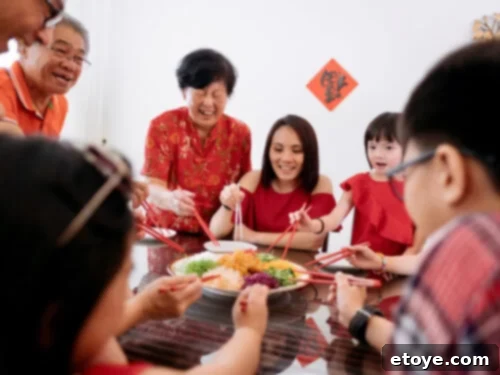
What were your thoughts on these captivating facts about Chinese New Year? How many of these ancient traditions and modern customs did you already know, and which ones brought a new perspective to this globally celebrated holiday?
Whether you actively celebrate the Lunar New Year yourself, or are simply keen on learning more about its rich tapestry of traditions, we sincerely hope this information has deepened your understanding and appreciation for the profound cultural significance of Chinese New Year. It’s a time of renewal, family bonding, and hopeful wishes for the future. Here’s to a year filled with immense happiness, bountiful good fortune, and enduring prosperity for all! Happy New Year, everyone – may this be your most auspicious and rewarding year yet. 🌟🧧✨
Explore More About Chinese New Year Traditions:
- Chinese New Year Recipes + Superstitions
Chinese New Year Recipes – Party Like It’s 4707!
Chinese New Year Recipes: What to eat if you want more money!
What to Eat for Chinese New Year
- 12 Unlucky Foods to Avoid this Chinese New Year
